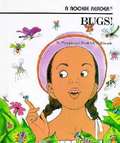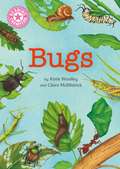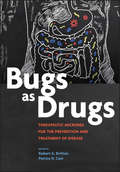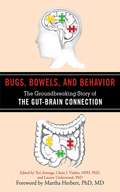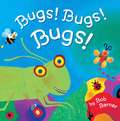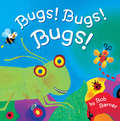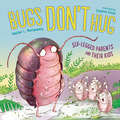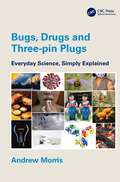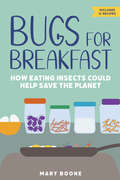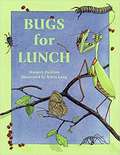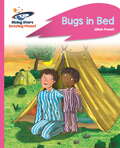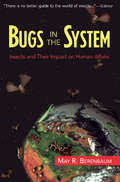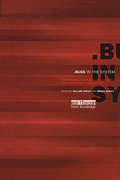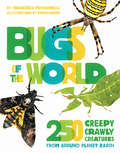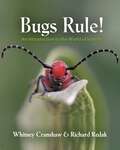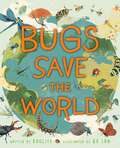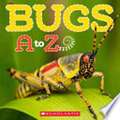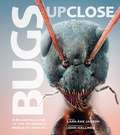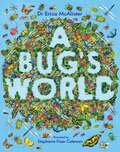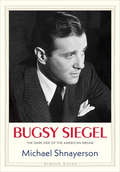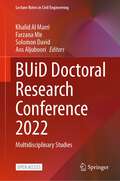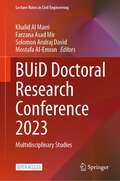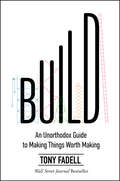- Table View
- List View
Bugs!
by Fredrick L. Mckissack Patricia C. MckissackSimple text on a variety of insects introduce the numbers one through five.
Bugs: Independent Reading Non-Fiction Pink 1a (Reading Champion #515)
by Katie WoolleyThis book is part of Reading Champion, a series carefully linked to book bands to encourage independent reading skills, developed with UCL Institute of Education (IOE)Bugs is a non-fiction text exploring how different bugs eat leaves. The repeated sentence structure offers readers the opportunity for a very first independent reading experience with the support of the illustrations.Reading Champion offers independent reading books for children to practise and reinforce their developing reading skills.This non-fiction text is accompanied by engaging artwork and a reading activity. Each book has been carefully graded so that it can be matched to a child's reading ability, encouraging reading for pleasure.
Bugs as Drugs: Therapeutic Microbes for Prevention and Treatment of Disease (ASM Books)
by Robert A. Britton Patrice D. CaniExamining the enormous potential of microbiome manipulation to improve health Associations between the composition of the intestinal microbiome and many human diseases, including inflammatory bowel disease, cardiovascular disease, metabolic disorders, and cancer, have been elegantly described in the past decade. Now, whole-genome sequencing, bioinformatics, and precision gene-editing techniques are being combined with centuries-old therapies, such as fecal microbiota transplantation, to translate current research into new diagnostics and therapeutics to treat complex diseases. Bugs as Drugs provides a much-needed overview of microbes in therapies and will serve as an excellent resource for scientists and clinicians as they carry out research and clinical studies on investigating the roles the microbiota plays in health and disease. In Bugs as Drugs, editors Robert A. Britton and Patrice D. Cani have assembled a fascinating collection of reviews that chart the history, current efforts, and future prospects of using microorganisms to fight disease and improve health. Sections cover traditional uses of probiotics, next-generation microbial therapeutics, controlling infectious diseases, and indirect strategies for manipulating the host microbiome. Topics presented include: How well-established probiotics support and improve host health by improving the composition of the intestinal microbiota of the host and by modulating the host immune response. The use of gene editing and recombinant DNA techniques to create tailored probiotics and to characterize next-generation beneficial microbes. For example, engineering that improves the anti-inflammatory profile of probiotics can reduce the number of colonic polyps formed, and lactobacilli can be transformed into targeted delivery systems carrying therapeutic proteins or bioengineered bacteriophage. The association of specific microbiota composition with colorectal cancer, liver diseases, osteoporosis, and inflammatory bowel disease. The gut microbiota has been proposed to serve as an organ involved in regulation of inflammation, immune function, and energy homeostasis. Fecal microbiota transplantation as a promising treatment for numerous diseases beyond C. difficile infection. Practical considerations for using fecal microbiota transplantation are provided, while it is acknowledged that more high-quality evidence is needed to ascertain the importance of strain specificity in positive treatment outcomes. Because systems biology approaches and synthetic engineering of microbes are now high-throughput and cost-effective, a much wider range of therapeutic possibilities can be explored and vetted.
Bugs, Bowels, and Behavior: The Groundbreaking Story of the Gut-Brain Connection
by Teri Arranga Martha Herbert Lauren Underwood Claire I. ViadroAccording to the National Institutes of Health, there are sixty to seventy million people affected by digestive diseases in the United States. The old proverb tells us "you are what you eat," and the latest science shows that this may be truer than we even thought. Diet has a profound effect on both physical and mental health. Most of the body's immune system is in the gut, so pathology and dysfunction in the gut and imbalanced gut flora can cause neuroinflammation and possibly even neurodegenerative disease over time.Featuring contributions from dozens of experts on gut disorders and related physical, mental, and behavioral health, this book will fascinate you as you read about the intriguing world of bad bugs, cytokine storms, and the environment in your belly that influences your brain. From the microscopic world of Clostridium to the complex communities of biofilm, Bugs, Bowels, and Behavior emphasizes one simple fact: The gut is connected to the brain.
Bugs! Bugs! Bugs!
by Bob Barner"Aspiring entomologists will develop a friendly, appreciative attitude toward the bugs they're most likely to encounter, and Barner's playful use of colors, shapes and words may even convert bug foes."--from Publisher's Weekly
Bugs! Bugs! Bugs!
by Bob BarnerPretty ladybugs, fluttering butterflies, creepy daddy longlegs, and roly-poly bugs are some of the familiar creatures featured in this whimsically illustrated insect album. Complete with an "actual size" chart and bug-o-meter listing fun facts about each bug, Bugs! Bugs! Bugs! will inform and entertain curious little bug lovers everywhere.
Bugs Don't Hug: Six-Legged Parents and Their Kids
by Heather L. MontgomeryMeet the mamas and papas of the insect world in this fresh and funny nonfiction look at how bugs are like us from popular science author and teacher Heather Montgomery.Most insects don't take care of their young, but some do--in surprising ways. Some bugs clean up after their messy little ones, cater to their picky eaters, and yes--hug their baby bugs. A fun and clever look at parenting in the insect world, perfect for backyard scientists and their own moms and dads. Back matter includes further information about the insects and a list of resources for young readers.
Bugs, Drugs and Three-pin Plugs: Everyday Science, Simply Explained
by Andrew MorrisFor the millions who remain curious about the world around them, but gained little from science at school, this book offers a way forward. Based on live discussions with adults from all walks of life, each chapter begins with an everyday experience, like swallowing a pill or watching a bee on a flower. The main scientific ideas underlying each topic are then explored, so that understanding of a set of fundamental concepts builds up gradually throughout the book. In contrast to more traditional approaches to science learning, topics range freely across the subject areas. The story of Covid, for example includes aspects of biology, chemistry, mathematics and social behaviour. Plain English is used throughout and mathematical expressions are avoided. Key points are illustrated with clear diagrams and photographs. By drawing on questions and perspectives of ordinary people, the book offers an introduction to basic ideas in science as a whole, rather than any one particular subject. For the adult wishing to make good a gap in their understanding it provides a starting point for entering the rich world of popular science.
Bugs for Breakfast: How Eating Insects Could Help Save the Planet
by Mary BooneMost North Americans would rather squish a bug than eat it. But roasted grubs are a favorite in Australia, the Batswana eat live termites, and stir-fried dragonflies are a delicacy in Indonesia. More than one-fourth of the world's population eats insects—a practice called entomophagy. Bugs for Breakfast helps middle-grade readers understand the role insects fill in feeding people around the world. Readers will be introduced to the insect specialties and traditions of various countries. They'll discover how nutritious bugs can be and why dining on insects is more environmentally friendly than eating traditional protein sources. Kids will see how making small changes in their own diets could help ensure no one goes hungry. It even includes 12 insect recipes! No doubt about it: teachers, librarians, and parents are hungry for books that entice young readers to be active participants in science.Bugs for Breakfast may not completely remove the yuck-factor from the notion of eating bugs, but it will open young readers' minds to what is happening in the world around them.
Bugs for Dinner (Fountas & Pinnell Classroom, Guided Reading)
by Susan DerKazarianNIMAC-sourced textbook
Bugs for Lunch (Fountas & Pinnell LLI Blue #Level J)
by Margery Facklam Sylvia LongDiscover the variety of bug-eaters—animal, plant, even human—in this exploration of both poetry and the natural world. Facklam’s playful rhymes mixed with Long’s vivid illustrations introduce young readers to an array of creatures as they munch on lunch. From a mantis perched and ready to prey on ladybugs, a spider trapping a fly, to the honey-drenched fur of a big brown bear chewing on a hive full of bees, Bugs for Lunch will give curious readers plenty of food for thought delivered in a playful package.
Bugs In The System: Insects And Their Impact On Human Affairs
by May R. BerenbaumAn introduction to insect physiology, genetics and behaviour which looks at the interaction between humans and insects, and explores both the positive and negative aspects of the relationship.
Bugs in the System: Redesigning the Pesticide Industry for Sustainable Agriculture
by William Vorley Dennis KeeneyThis important, interdisciplinary contribution to the 'greening' business debate looks at one of the most environmentally controversial industries - the chemical pesticide industry. If that sector can be put on to an environmentally sustainable footing, then the same may be possible for virtually all of industry. As business and environmental trends turn the pesticide industry's focus to biotechnology and seed engineering, this book examines the extent to which the industry is prepared to exploit new business opportunities in a more regenerative agriculture and draws attention to the industry's economic, environmental and social responsibilities.
Bugs of the World: 250 Creepy-Crawly Creatures from Around Planet Earth
by Francesco TomasinelliFrom moths and beetles to worms and spiders, this completely illustrated, fact-filled book features hundreds of creepy-crawlies for kids to discover and explore.This gorgeously illustrated book reveals the hidden world of some of the most mind-boggling insects. Divided into categorical sections like herbivores and predators, Bugs of the World includes beetles, wasps, bees, ants, caterpillars, butterflies, dragonflies, spiders, flies, crickets and grasshoppers, centipedes and millipedes, and more. Each of the 250 insects featured is accompanied by beautiful illustrations and facts about the creature, including its common name and scientific name, its size, its continent of origin, and a brief description of its unique characteristics. Kids will also learn about the different life cycles of insects, why they are important to ecology and our world, the planet's most dangerous insects, how bugs camouflage themselves, and so much more.
Bugs Rule!: An Introduction to the World of Insects
by Whitney Cranshaw Richard RedakThe essential illustrated introduction to insects for nonscience majorsBugs Rule! provides a lively introduction to the biology and natural history of insects and their noninsect cousins, such as spiders, scorpions, and centipedes. This richly illustrated textbook features more than 830 color photos, a concise overview of the basics of entomology, and numerous sidebars that highlight and explain key points. Detailed chapters cover each of the major insect groups, describing their physiology, behaviors, feeding habits, reproduction, human interactions, and more.Ideal for nonscience majors and anyone seeking to learn more about insects and their arthropod relatives, Bugs Rule! offers a one-of-a-kind gateway into the world of these amazing creatures.Places a greater emphasis on natural history than standard textbooks on the subjectCovers the biology and natural history of all the insect ordersProvides a thorough review of the noninsect arthropods, such as spiders, scorpions, centipedes, millipedes, and crustaceansFeatures more than 830 color photosHighlights the importance of insects and other arthropods, including their impact on human societyAn online illustration package is available to professors
Bugs Save the World
by BuglifeFind out why bugs are so important - to humans, animals and the survival of our planetOur amazing bugs are in trouble. Without bugs, plants would not be able to make flowers or fruit. If bugs disappeared, so would strawberries, apples, beans and tomatoes, and even chocolate. Without them, we couldn't grow enough food to feed us all. If we lost bugs, we would also lose creatures who depend on them for survival, such as songbirds, badgers, bats and fish.Written by the conservation charity Buglife, this book shows the reasons why bugs are so important - to humans, animals and the survival of our planet. Discover bugs in all shapes, sizes and colours, and learn how these tiny creatures are going to help SAVE the world. You can also discover what you can do to help protect bugs. Buglife, the Invertebrate Conservation Trust, is dedicated to protecting insects, bugs and all invertebrate species.This book supports science work in schools by looking at different animals, adaptation, food chains, life cycles, habitats and climate change.In the accompanying book, Plants Save the World, you can discover why plants are vitally important to the survival of our planet, too!
Bugs A To Z
by Caroline LawtonAn essential A to Z bug book for young readers. The perfect book for all kids who are fascinated with bugs. Simple text from A to Z provides buggy facts and figures. Larger than life full-color photographs of creepy crawlies include locusts, caterpillars, beetles, flies, grasshoppers, ants, praying mantis, and more!
Bugs Up Close: A Magnified Look at the Incredible World of Insects
by Lars-Åke Janzon John HallménBugs are usually so small that we hardly notice them, let alone think of them as living beings. But call upon the magnifying glass, and a shapeless jumble of legs, wings, and antennae suddenly start staring back at us.About 80 percent of the Earth's animals are insects. While there are millions of different species, we rarely see many of them . . . until now. Thanks to the photography of John Hallmén, who took a camera and magnified these magnificent creatures one hundred times, we can see what we've never been able to see before.Bugs Up Close takes readers on a journey into a world rarely seen, with incredible photographs of such insects as:Crane fliesYellow meadow antsBlack fungus beetlesTreehoppersAnd many more!The diversity of this insect civilization is striking and unknown to most. An insect we may never have thought twice about now looks like a creature from outer space. Fascinating and somewhat monstrous details such as compound eyes, antennae, and sharp mouth parts are visible, and with text by Lars-Åke Janzon, Bugs Up Close is an amazing close look into the strange and beautiful world of insects.
A Bug's World
by Erica McAlisterDid you know that...Flies can help us solve crimes?Spiders can be astronauts?Moths are the ultimate fashion designers?From making our food to keeping the planet clean and solving crimes, bugs come to our rescue every day. Often without us even realising!Discover the extraordinary things that bugs do for us - and how we can look after them too - in this vibrant gift book written by the Natural History Museum's senior entomologist.
Bugsy Siegel: The Dark Side of the American Dream (Jewish Lives)
by Michael ShnayersonThe story of the notorious Jewish gangster who ascended from impoverished beginnings to the glittering Las Vegas strip"A highly readable, fast-moving contribution to the annals of 20th-century organized crime."—Kirkus Reviews In a brief life that led to a violent end, Benjamin &“Bugsy&” Siegel (1906–1947) rose from desperate poverty to ill-gotten riches, from an early-twentieth-century family of Ukrainian Jewish immigrants on the Lower East Side to a kingdom of his own making in Las Vegas. In this captivating portrait, author Michael Shnayerson sets out not to absolve Bugsy Siegel but rather to understand him in all his complexity. Through the 1920s, 1930s, and most of the 1940s, Bugsy Siegel and his longtime partner in crime Meyer Lansky engaged in innumerable acts of violence. As World War II came to an end, Siegel saw the potential for a huge, elegant casino resort in the sands of Las Vegas. Jewish gangsters built nearly all of the Vegas casinos that followed. Then, one by one, they disappeared. Siegel&’s story laces through a larger, generational story of eastern European Jewish immigrants in the early- to mid-twentieth century.
Buhler: Mobilizing Industry Around A Common Purpose
by Franz Wohlgezogen Malini Sen Ranjay GulatiCase
BUiD Doctoral Research Conference 2022: Multidisciplinary Studies (Lecture Notes in Civil Engineering #320)
by Khalid Al Marri Farzana Mir Solomon David Aos AljubooriThis open access book presents selected contributions on a wide range of scientific and technological areas originating from the BUiD Doctoral Research Conference (BDRC 2022). It discusses the following topics: project management, macroeconomic factors, Fourth Industrial Revolution, agility, multiculturalism, diversity, inclusion, leadership, language, discourse analysis, curriculum, critical thinking, programming, online learning, and natural ventilation. The contributions reflect the multifaceted nature of the research in three academic disciplines, i.e., humanities, formal science, and applied science. This publication shares with its readers genuine research studies and reflections from practitioners on the current practice and understanding in the three academic disciplines. The significant findings of these studies have considerable educational, industrial, and economic implications.
BUiD Doctoral Research Conference 2023: Multidisciplinary Studies (Lecture Notes in Civil Engineering #473)
by Khalid Al Marri Farzana Asad Mir Solomon Arulraj David Mostafa Al-EmranThis open access book presents selected contributions on a wide range of scientific and technological areas originating from the BUiD Doctoral Research Conference (BDRC 2023). It discusses the following topics: project management, macroeconomic factors, Fourth Industrial Revolution, agility, multiculturalism, diversity, inclusion, leadership, language, discourse analysis, curriculum, critical thinking, programming, online learning, and natural ventilation. The contributions reflect the multifaceted nature of the research in three academic disciplines, i.e., humanities, formal science, and applied science. This publication shares with its readers genuine research studies and reflections from practitioners on the current practice and understanding in the three academic disciplines. The significant findings of these studies have considerable educational, industrial, and economic implications.This is an open access book.
Build: An Unorthodox Guide to Making Things Worth Making
by Tony FadellTony Fadell led the teams that created the iPod, iPhone and Nest Learning Thermostat and learned enough in 30+ years in Silicon Valley about leadership, design, startups, Apple, Google, decision-making, mentorship, devastating failure and unbelievable success to fill an encyclopedia.So that’s what this book is. An advice encyclopedia. A mentor in a box. Written for anyone who wants to grow at work—from young grads navigating their first jobs to CEOs deciding whether to sell their company—Build is full of personal stories, practical advice and fascinating insights into some of the most impactful products and people of the 20th century.Each quick 5-20 page entry builds on the previous one, charting Tony’s personal journey from a product designer to a leader, from a startup founder to an executive to a mentor. Tony uses examples that are instantly captivating, like the process of building the very first iPod and iPhone. Every chapter is designed to help readers with a problem they’re facing right now—how to get funding for their startup, whether to quit their job or not, or just how to deal with the jerk in the next cubicle.Tony forged his path to success alongside mentors like Steve Jobs and Bill Campbell, icons of Silicon Valley who succeeded time and time again. But Tony doesn’t follow the Silicon Valley credo that you have to reinvent everything from scratch to make something great. His advice is unorthodox because it’s old school. Because Tony’s learned that human nature doesn’t change. You don’t have to reinvent how you lead and manage—just what you make. And Tony’s ready to help everyone make things worth making.
